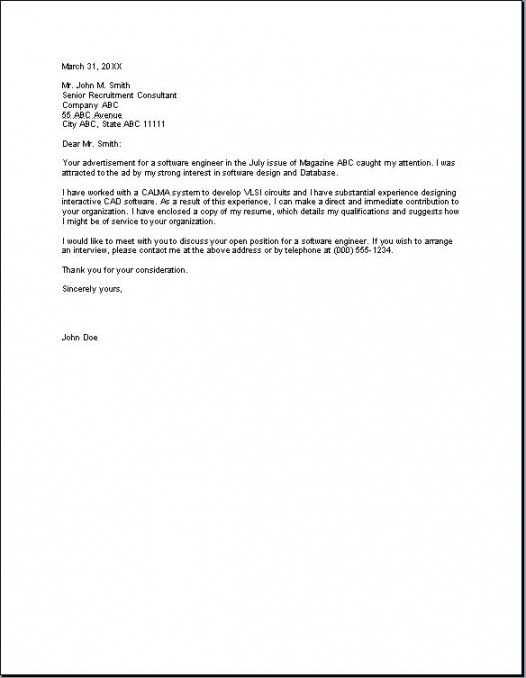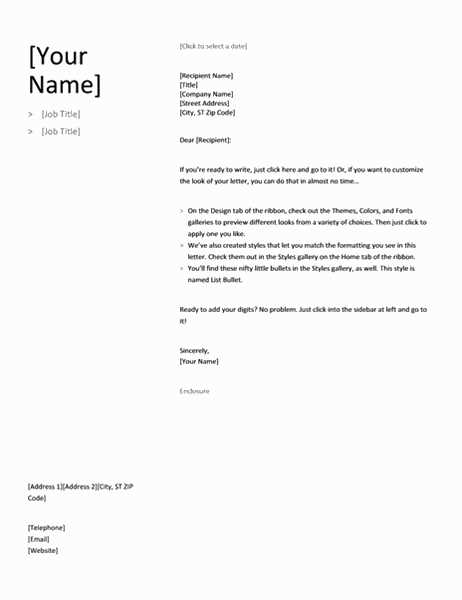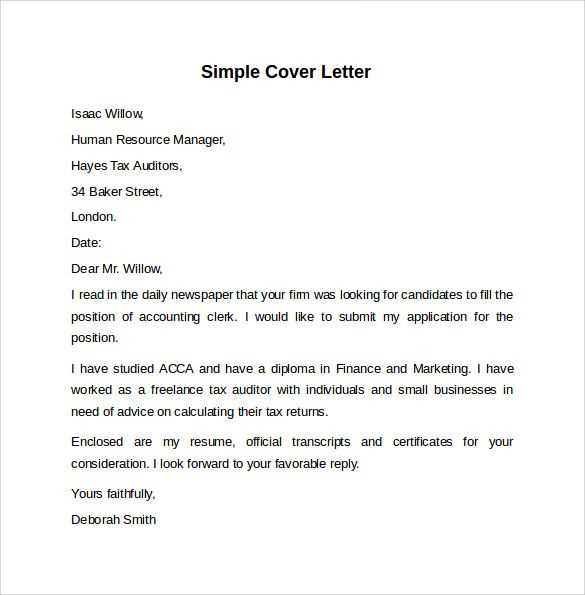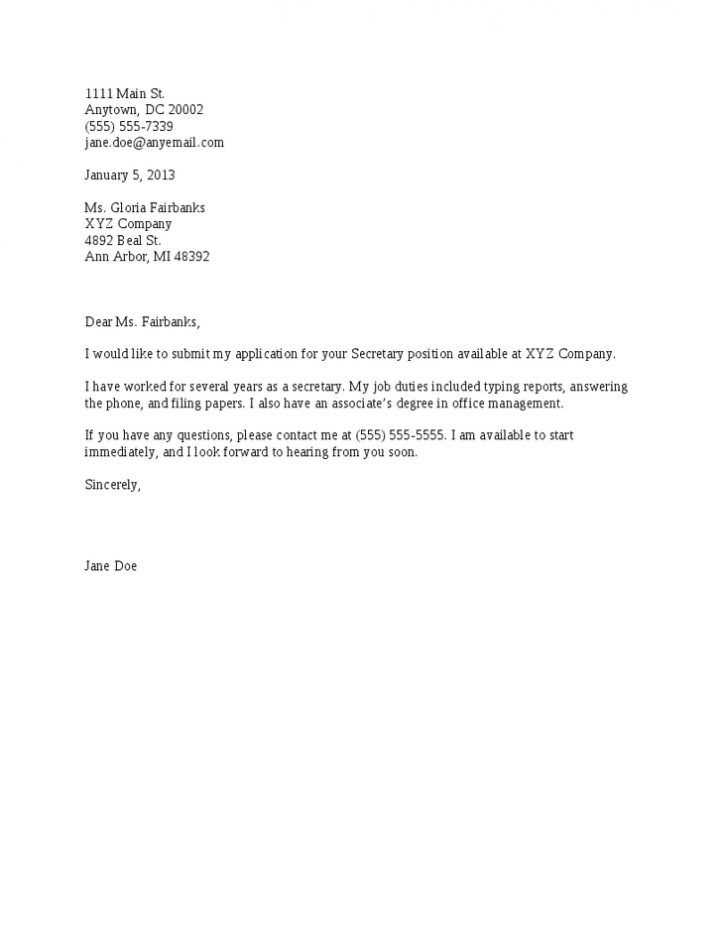Simple covering letter template

A well-structured covering letter can make a strong impression on a potential employer. Focus on presenting your qualifications and enthusiasm for the position without unnecessary fluff. Use a clear format, keeping it concise and straightforward. The goal is to showcase your skills and experience in a way that directly aligns with the job requirements.
Start with a brief introduction, highlighting the position you’re applying for. Avoid generic openings and immediately mention why you’re excited about the opportunity. Follow this with a clear explanation of why you’re a great fit, focusing on specific experiences or achievements that demonstrate your capabilities. Keep it personal but professional–show your interest in the company without overselling yourself.
Finish with a confident closing statement, reaffirming your enthusiasm and inviting the reader to contact you for an interview. Keep the tone polite and respectful, making it easy for them to take the next step. The right combination of warmth and professionalism can set you apart from other candidates.
Simple Covering Letter Template
Begin with your name, address, and contact details at the top of the letter. Align them to the left or center, depending on your preference. Below that, include the date and the recipient’s details (name, position, company, and address). Use a formal greeting like “Dear [Recipient’s Name],”.
Start the letter by clearly stating the purpose of your application. For example, “I am writing to express my interest in the [Job Title] position at [Company Name].” This lets the reader know right away what you’re applying for.
Next, highlight a couple of key strengths or experiences that align with the job requirements. Focus on specific skills, accomplishments, or previous roles. Use concise, targeted sentences to showcase how you meet the qualifications without over-explaining.
Close by thanking the reader for their time and consideration. Express your desire for a meeting or interview. For example, “I would welcome the opportunity to discuss how my skills and experiences can contribute to your team.” End with a polite sign-off like “Sincerely” or “Best regards,” followed by your name.
Choosing the Right Format for Your Covering Letter

Pick a clear and simple structure for your covering letter. Start with a formal greeting, followed by a concise introduction that highlights your interest in the position. Then, focus on the body, where you briefly explain your qualifications and how they relate to the job. Finish with a polite closing, ensuring your contact details are easy to find.
Stick to a professional layout. Use standard fonts like Arial or Times New Roman with 10-12 point size. Keep margins at 1 inch on all sides for a neat look. Align the text to the left and avoid unnecessary elements like graphics or colors.
Choose between block or semi-block formats. The block format has all paragraphs aligned to the left with no indentation. It is simple and widely accepted. The semi-block format allows for indented paragraphs, offering a slightly more traditional style. Pick the one that fits your tone and the company culture.
Ensure your letter is tailored to the job. Highlight how your skills match the specific requirements mentioned in the job posting. Avoid using generic statements and focus on what makes you a great fit for the role.
Personalizing the Opening Paragraph
Begin with a clear mention of the position you’re applying for and how you found the job. Mention any mutual connections or personal experiences that link you to the company. This sets the tone and shows you’ve done your research. Avoid generic phrases like “I’m excited to apply.” Instead, show specific enthusiasm based on the company’s values, culture, or the job description.
For example, if a shared connection referred you, mention their name early on. If you’re familiar with the company’s projects or success, reference them to highlight your understanding of their work.
| Example | Explanation |
|---|---|
| “After learning about your recent project on XYZ through John Doe, I am excited to offer my experience in ABC to your team.” | Here, you mention a specific connection (John Doe) and a project, which personalizes the paragraph. |
| “Having admired your commitment to innovation in DEF, I am confident my background in GHI aligns perfectly with your team’s goals.” | This approach shows genuine interest by connecting personal experience with the company’s mission. |
Highlighting Relevant Skills and Experience

Focus on the skills directly aligned with the job requirements. Be specific about the tools and methods you’ve used, highlighting your proficiency with them. For example, if the role demands project management, mention specific software like Asana or Trello, and any leadership roles you’ve taken on in past positions. Keep the emphasis on measurable achievements, such as “led a team of five to complete a project two weeks ahead of schedule.”
Draw clear connections between your experience and how it directly benefits the role you’re applying for. If the position requires customer service expertise, mention your experience handling high volumes of inquiries and resolving issues efficiently. Provide examples of how your skills directly contributed to improving customer satisfaction or boosting sales.
Show your ability to adapt by discussing new skills you’ve acquired and how quickly you picked them up. This shows your commitment to growth and staying updated with industry standards. Reference certifications or courses you’ve completed that enhance your qualifications for the job.
Explaining Your Motivation for the Job
Focus on the specific reasons you are excited about this position. Show how your skills match the company’s goals and how this role fits your career path. Think about your interest in the work itself, the company, and the challenges the job offers.
- Identify your passion for the industry or company. Highlight what excites you about their products, services, or mission.
- Show how your experience aligns with the role’s requirements. Connect your previous work with the tasks you would handle in this position.
- Explain how this job supports your career growth. Mention any new skills you want to develop or goals you wish to achieve.
- Be specific about what motivates you to contribute. Whether it’s a desire to solve complex problems or work with a talented team, make it clear.
Avoid generic statements. Instead, focus on what makes this role and company a perfect fit for your goals. The more specific you can be, the more convincing your motivation will appear.
Ending Your Letter with a Clear Call to Action

Conclude your letter by making your request clear and actionable. Instead of vague language, ask for a specific response or action. For example, “I look forward to discussing this opportunity further and will be available for a call next week,” or “Please feel free to contact me at your convenience.” This approach provides clarity and shows confidence in your message.
Ensure your call to action aligns with the purpose of your letter. Whether you’re seeking a job interview, requesting a meeting, or following up on a previous conversation, make it easy for the recipient to know how to proceed. A direct yet polite request encourages a timely response.
Close with a friendly yet professional sign-off, such as “Looking forward to your reply,” followed by a courteous thank-you. Keep the tone positive and forward-looking, ensuring the reader feels encouraged to take the next step.
Final Touches: Proofreading and Formatting
Ensure your letter is free of errors by proofreading it thoroughly. Read it multiple times, focusing on grammar, punctuation, and spelling. Consider reading it aloud to catch mistakes that might go unnoticed while reading silently.
Check the overall structure and flow of your letter. Make sure your paragraphs are logically ordered and each section transitions smoothly to the next. Avoid long, complex sentences that may confuse the reader.
- Verify the recipient’s name, title, and address to ensure accuracy.
- Check for consistency in font style, size, and spacing. Use a professional, easy-to-read font like Arial or Times New Roman in size 12.
- Ensure your margins are consistent, typically set at 1 inch on all sides.
- Keep the letter concise, aiming for no more than one page.
- Review the salutation and closing. Ensure they align with the tone of the letter and are appropriately formal.
After making revisions, take a break and return with fresh eyes. A final read-through will help you spot any overlooked issues.